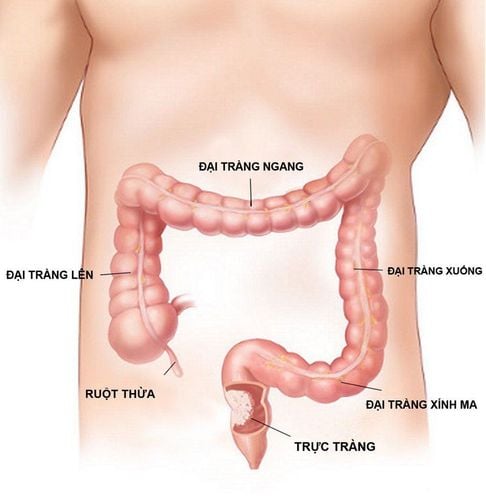This is an automatically translated article.
Vinsalamin drug with the main ingredient is Mesalamin, which is commonly used in the treatment of cases of bleeding ulcerative colitis or Crohn's disease. Learning the necessary information about the composition, indications, contraindications, dosage and side effects of Vinsalamin will help patients improve the effectiveness of treatment.
1. What is Vinsalamin?
Vinsalamin is prepared in the form of enteric-coated film-coated tablets of 250, 400 and 500 mg, with the main ingredients including:
Active ingredients: Mesalamin or Mesalazine content of 250, 400 or 500mg. Excipients: Just enough 1 film-coated tablet according to the manufacturer's weight. Mechanism of action:
Active ingredient Mesalamin or Mesalazine has a chemical structure of 5 Aminosalicylic Acid (5-ASA). The exact mechanism of action of the active ingredient Mesalamin is not known because the inflammatory response is often quite complex, however some studies suggest that Mesalamin often has a local effect rather than a systemic effect. Some data indicate that Mesalamin inhibits Cyclooxygenase, thereby reducing the formation of Prostaglandin in the colon. The result of this process is to counteract the production of metabolites of arachidonic acid, which are often increased in patients with chronic inflammatory bowel disease.
2. What are the effects of Vinsalamin?
Vinsalamin is indicated for treatment in the following cases:
Treatment of mild to moderate exacerbations and maintenance treatment of bleeding ulcerative colitis. Maintenance treatment of Crohn's disease.
3. Contraindications of Vinsalamin
Hypersensitivity to any component of Vinsalamin. History of allergy to other medicines containing Mesalamin. History of allergy to salicylates or hypersensitivity to sulfasalazine. Patients with severe renal failure (GFR < 20 ml/min), severe liver failure. Patients who are on anticoagulant therapy or have coagulation disorders. The patient has advanced gastric ulcer. Children under 2 years old. Patient has pyloric stenosis or bowel obstruction.
4. Dosage and usage of Vinsalamin
How to use the drug: Use Vinsalamin with meals.
Dosage of Vinsalamin for adults:
Treatment of ulcerative colitis: Initial dose: Take 0.5 - 1g/time x 3 times/day for 6 weeks or take 2.5 - 4.5g/time x 1 times/day for 8 weeks. Maintenance dose: Take 0.5g/time x 3 times/day. Crohn's disease Maintenance dose: 0.5g/time x 3-4 times/day. Dosage of Vinsalamin for children:
Treatment of ulcerative colitis Initial dose: Children 5 - 15 years old take 15 - 20mg/kg/time x 3 times/day, maximum use 1g. Children 15 - 18 years old take 0.5 - 1g / time x 2 times / day. Maintenance dose: Children 5-15 years old take 10mg/kg/time x 2-3 times/day, maximum use 500mg. Children 15-18 years old take 2g / time x 1 time / day. Treatment of Crohn's disease: Children 5-15 years old: Oral 10mg/kg/time x 2-3 times/day, maximum use 500mg. Children 15-18 years old: Take 2g/time x 1 time/day.
5. Note when using Vinsalamin
Side effects encountered when using Vinsalamin:
Common: Systemic symptoms include fatigue, weakness, headache, dizziness, fever. Digestive disorders such as nausea, vomiting, abdominal pain, diarrhea, belching, constipation, dyspepsia, increase symptoms of colitis. Skin symptoms such as rash, itching, urticaria, acne. Respiratory symptoms such as cough, sore throat. Rare: Blood count abnormalities aplastic anemia, agranulocytosis, agranulocytosis, leukopenia, neutropenia, thrombocytopenia and hematopoietic disorders. Circulatory symptoms, pericarditis, myocarditis. Musculoskeletal symptoms such as cramps, back pain, joint pain. Urinary symptoms such as nephrotic syndrome, nephritis. Other symptoms such as photosensitivity, increased liver enzymes, hepatitis, increased triglycerides, pancreatitis, Mesalamin intolerance syndrome, hair loss. When detecting the above side effects or any other abnormalities after taking Vinsalamin, patients and relatives should promptly notify the treating doctor or go to a medical facility for timely treatment.
Note the use of Vinsalamin in the following subjects:
Be careful when using Vinsalamin in the elderly, people with a history of or are experiencing unexplained bleeding, anemia, purpura, fever or sore throat. Liver failure, mild to moderate renal failure, gastrointestinal ulceration. Pregnancy: According to the classification of the US Food and Drug Administration (FDA), active ingredient Mesalamin belongs to group B, there is no evidence of risk on pregnancy. However, caution should be exercised when using Vinsalamin in this subject. Lactation: There are no data to confirm whether Mesalamin can pass into breast milk, and Vinsalamin should not be used in nursing women. Drivers or machine operators can often experience side effects such as fatigue, weakness, headache, dizziness... after using Vinsalamin.
6.Vinsalamin drug interactions
Interactions with other drugs:
Combined use of Vinsalamin with Sulfasalazine, non-steroidal anti-inflammatory drugs (NSAIDs) may increase the risk of nephrotoxicity. Concomitant use of Vinsalamin with Warfarin may increase prothrombin time. Drugs that reduce gastric acid levels, proton pump inhibitors, H2 antagonists reduce the effect of Vinsalamin. Vinsalamin increases the effect of chickenpox vaccine, sulfonylurea lowers blood sugar. Vinsalamin reduces the effect of cardiac glycosides, furosemide, spironolactone, rifampicin, probenecid and sulfinpyrazone. The combined use of Vinsalamin with lactulose and similar substances can lower stool pH and prevent the release of the active ingredient Mesalamin. Above is basic information about ingredients, indications, contraindications, dosage and notes when using Vinsalamin. This is a prescription drug, so patients need to carefully read the instructions for use, strictly follow the treatment instructions of the doctor or pharmacist to achieve the best results.













